Man, clutter is… old. Your average high-end system espousing separate dedicated components could see a head count of eight or nine boxes, each needing power and interface cable. That’s a lot. Partly with those aspects of placement and cabling logistics in mind, Italian audio specialist Gold Note devised a high-end digital hub which greatly reduces your component inventory while saving you some hard-earned. The promise is there too, for elevated sound quality. Gold Note is renowned for high performance products – whether analogue or digital – with build quality and engineering being consistent trademarks. Enter the DS-1000 EVO Streaming DAC.
Striking Gold Note
I vividly recall my visit to the Gold Note factory in dreamy Tuscany back in 2017 (factory feature here). Gold Note has since then grown exponentially as an audio manufacturer. The company now inhabits a significantly larger custom designed facility.
It’s relevant to note that SoundStage! founder Doug Schneider and I agree on how crucially important it is for audio journalists to visit manufacturers. By doing so, we gain an enhanced appreciation of company ideologies, manufacturing machinations and the engineering and design department processes, while expanding our knowledge of the various stages of product development. These are invaluable tools for audio journalists. As a result, we also gain a more complete vision of the industry as a whole. I’m quite confident in stating that we, at the SoundStage! Network, are the most travelled in the industry.
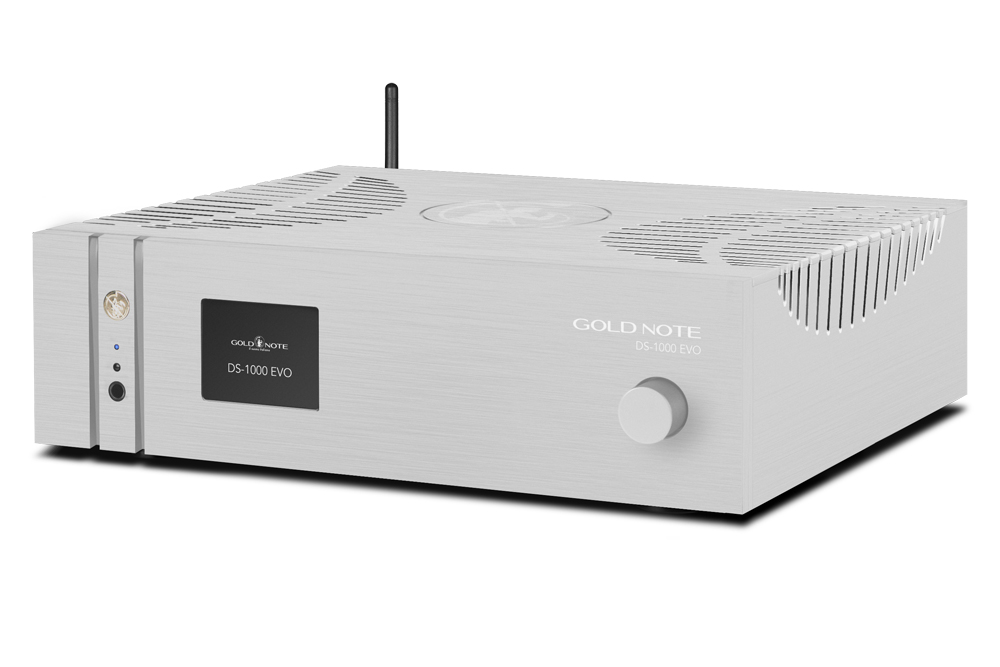
Like all of this Italian audio manufacturer’s products, the Gold Note DS-1000 EVO is a beautifully assembled and rather solid component available in anodised black, silver and the company’s long-running gold finishes. There’s a sense of no-nonsense functionality to the DS-1000 EVO, especially given the minimalistic buttonry on the unit’s fascia, while the solid 10kg weight inspires confidence in terms of overall build quality.
It may be a simple design externally, but the unit is bristling with features and functionality. In fact, Gold Note claims it the most advanced digital component it has ever designed.
OK, giddy-up. DS-1000 EVO is a high-resolution, Roon Ready streamer capable of Airplay, Tidal, Spotify, MQA, Qobuz, vTuner, and Deezer playback. Both Tidal and Spotify are also ‘Connect’ standard for direct corresponding app control. It also has UPnP/DNLA capabilities and NAS drive playback via tablet or smartphone. Also on-board is a superb digital-to-analogue converter and a high quality headphone amplifier.
Gold Note has designed its own playback app which is free to download from the App Store (for iOS and Android) and which provides access to all the DS-1000 EVO’s features and functions. The app incorporates a basic music player and streaming service management. Gold Note provides a video tutorial for app setup which is accessible via either the company website or via YouTube directly. The app’s operation is intuitive, reliable and, for example, Airplay was a cinch to activate and worked as expected.
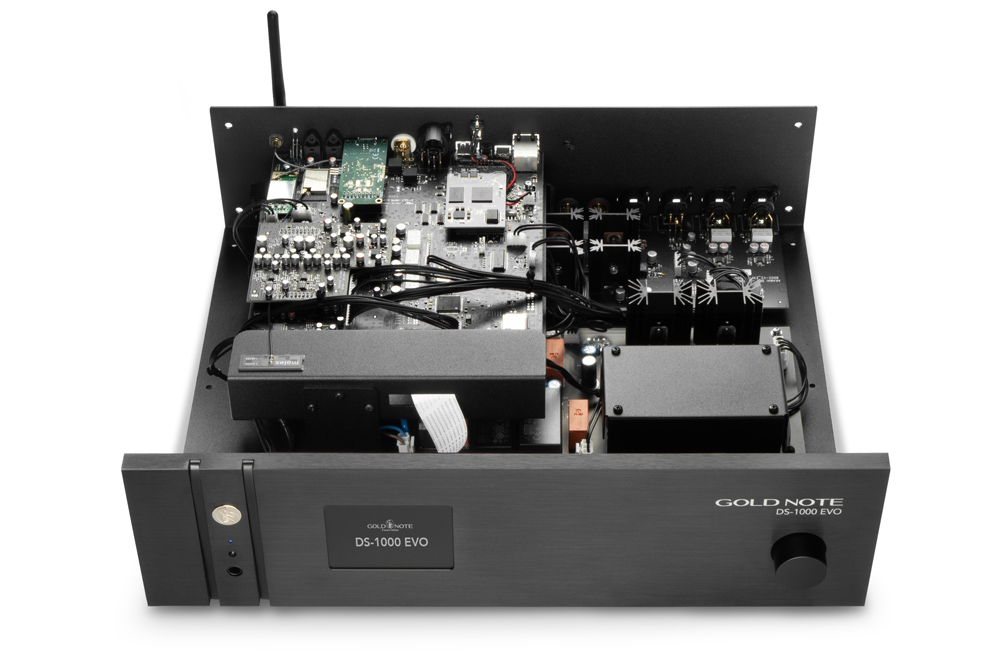
The DS-1000 EVO features a high quality built-in digital-to-analogue converter employing two AKM AK4493 dual-mono converter chips. The DAC is MQA compatible while PCM resolution spans to 32-bit/384 kHz and DSD512. The various circuit stages have been designed with maximum attention to sound quality, exemplified by the Class-A output stage design.
Further, there’s an alternative version called ‘DS-1000 EVO Line’ which extends the connectivity capabilities to include a line level input designed around a Class-A preamplifier circuit. The ‘Line’ version provides both a variable volume control – for direct power amplifier hook-up like a preamp – or a fixed-level direct-from-DAC output.
Yes, connectivity is comprehensive. The digital input bank features, from left to right, an RJ45 network socket, a USB-A port with up to DSD256 and PCM up to 32-bit/384 kHz with FAT32/NTFS format (thumb drives up to 32Gb), an XLR AES/EBU at up to PCM 24-bit/192 kHz, an RCA S/P-DIF coaxial PCM up to 24-bit/192 kHz, a USB-B marked ‘USB DAC’ asynchronous up to DSD512 and PCM up to 32-bit/384 kHz, and finally, two Toslink optical sockets (PCM 24-bit/192 kHz). Alongside those is an aerial for wireless streaming with dual-band, high-definition Bluetooth 5.0 (44 kHz/16-bit). The unit is also Wi-Fi capable. The DS-1000 EVO is compatible with just about every file type under the sun (AIFF, FLAC, WAV, OGG, ALAC, MP3, Monkey’s and on, and on – it’s like an alphabet zoo in there).
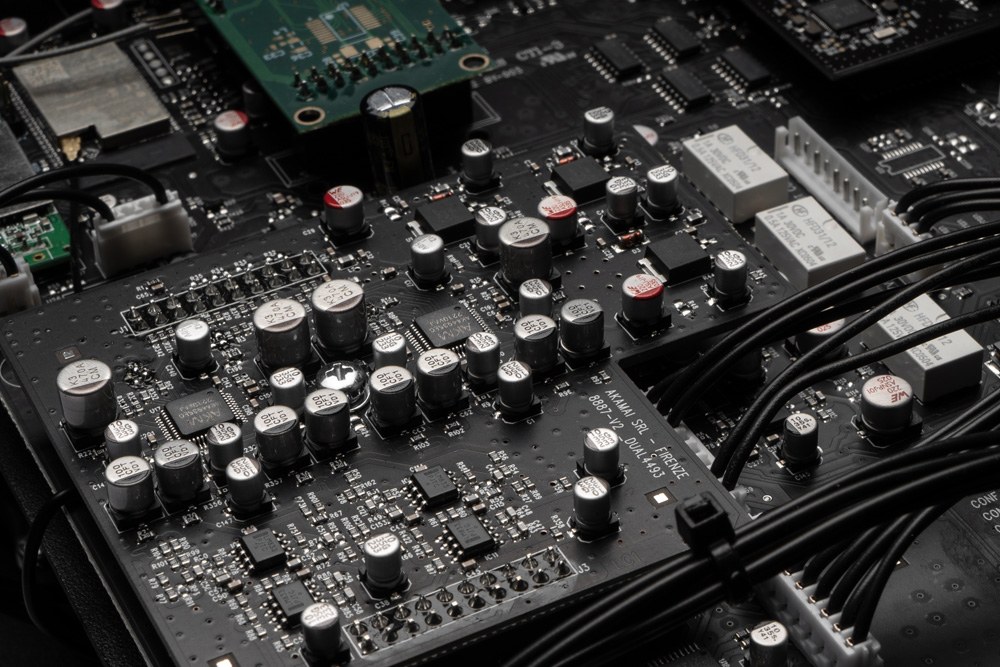
Analogue outputs are via balanced XLR and unbalanced RCA (output 100 ohms and 50 ohms respectively). The ‘Line’ version offers balanced XLR and unbalanced RCA inputs. There are twin 5-pin XLR-type sockets which accept the PSU-1250 (300 watts) and PSU-1000 (200 watts) inductive power supply upgrade. The upgrade power supplies feature a matching chassis, built with the same overall high quality, for seamless design integration.
The DS-1000 EVO’s front panel sports a minimalist button list. There, you’ll find a 6.5mm jack headphone amplifier output, a small LED colour display screen, and a large rotary knob which serves as a navigator to a number of operational functions. The dedicated high quality headphone amplifier features an option for low/high sensitivity to suit a wide range of headphones.
As stated above, the fascia’s rotary knob performs a number of functions. A long press turns the DS-1000 EVO on/off, while rotating it toggles through the various menu options which can be selected with a short press. The colour display shows the artwork for the music being streamed/played, with the graphics looking decent enough quality wise. However, my unit seemed a little inconsistent in terms of finding and displaying the artwork. Sometimes it would take a couple of tracks into the album for the artwork to show, other times it just didn’t show at all (at least a Gold Note logo is displayed rather than a blank screen). This happened intermittently and is open to a fairly simple software update fix (Firmware 2.2.8 at the time of review). The DS-1000 EVO is delivered with a full function remote control.
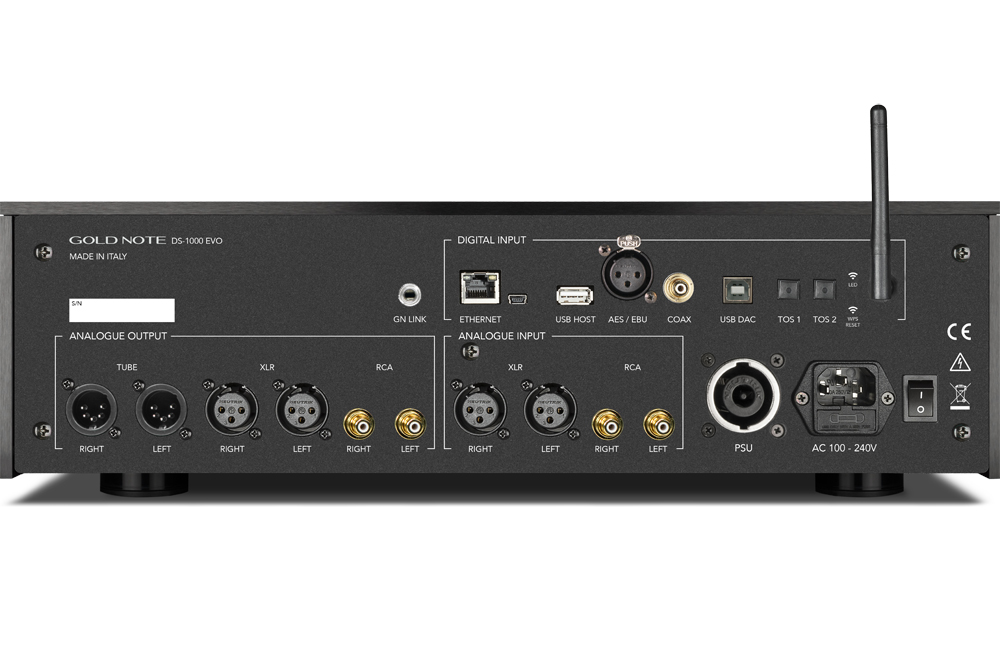
The specifications for the DS-1000 EVO are pretty straightforward, as they are less crucial, in terms of influencing the sonics, when compared to a pair of speakers or an amplifier. Having said that, they look pretty good. Gold Note quotes a Frequency Response of 20 Hz to 20 kHz at +/-0.1dB, a Total Harmonic Distortion (THD) of 0.001% maximum, a Signal-to-Noise Ratio (SNR) of 125dB and a Dynamic Range (DR) of 120dB.
The DS-1000 EVO operated faultlessly throughout its five-to-six-week stay in-situ, aside from the trivial matter of the artwork display. The app connected without a hitch and the unit was identified super-fast as a source via Roon, my preferred playback method for file and music service streaming.
Golden Ears
It’s so handy to have immediate access to a high quality audio playlist via Roon. In my case, I’ve been assembling a high quality recordings playlist over several years and it’s ever expanding. It’s a mix of audiophile staples (most of them, but with some exceptions, used for evaluation and rarely for pure musical enjoyment) and a proportion of well recorded tracks which serves both my sonic quality biases and musical interests. I think it’s universally accepted that the quality of computer audio, whether via file playback or streamed from the various high quality music providers such as Tidal and Qobuz, is now of a very high standard in terms of sound performance.
While I briefly sampled the music wirelessly in the Gold Note app during my auditioning period, the majority of my listening was conducted using Roon via the DS-1000 EVO’s in-built DAC through the USB input fed from a server. I’ve got to say, I like Gold Note’s implementation of the AKM chips. I found the sound smooth, yet very detailed and with excellent bass control while complex music was expertly separated.
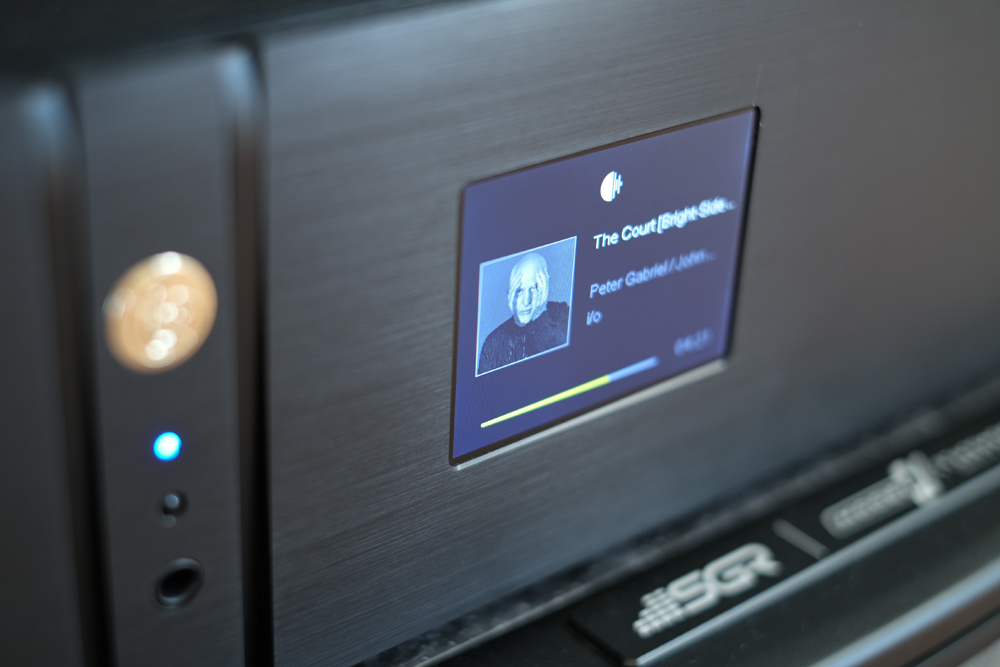
A regularly played track within the ‘audiophiley’ selection is the superbly recorded “Desert Blanc” from the Nicolas Parent Trio’s Mirage album. Man, did the DS-1000 EVO pull some detail through. The musical beauty of every nuance and the tonal purities of the guitar, upright bass and percussion were offered with superb insights. The strings resonated with tremendous transient fidelity, while the bass was tight, and fast, and the steely drum echoed with metallic resonance and extended decay.
The DS-1000 EVO showed excellent ambience through live recordings. Ryan Adams’ Ten Songs From Live at Carnegie Hall showed a consistently wide, deep and tall soundstage with the singer songwriter always locked-in within a focused central image. As has been the case with good hi-fi components I’ve reviewed, the touching “Sylvia Plath” communicated the emotions Adams feels while performing what may be deduced, within the context of the track, as an overwhelming desire to experience a powerful, loving bond. The Streaming DAC delivers, and that strong vibe, that connection develops, down the chain, between hardware, music and listener. Can you not feel something when you hear Adams singing the lyrics, “… And she and I would sleep on a boat, and swim in the sea without clothes, with rain falling fast on the sea, while she was swimming away, she'd be winking at me, telling me it would all be okay…”
“Too Many Angels” from Jackson Browne’s Solo Acoustic Vol. 1 had Browne’s vocal oscillations and his subtly nasal tone tracking faithfully. He’s moderately close-miked, something that allows a more realistic dynamic shading without the forwardness, yet the DS-1000 EVO never sounded etched or bright. It presented as super-clean rendering of Browne’s vocals, allowing easy discernment of the excellent lyrics while also showcasing the clarity of his precise guitar skills.
Due to its excellent resolution capabilities, I suspected the DS-1000 EVO’s handling of classical music would be enjoyable. Streaming several orchestral pieces, the Gold Note provided an enveloping soundfield of appropriate dimensions for the genre and on par with other very good streamers I’ve tested. Perhaps my own dedicated 432 EVO AEON Reference streamer (that nomenclature word again) spread music a little wider and deeper, but it was marginal. DS-1000 EVO was more than capable of spreading orchestras widely, deeply and with terrific height dimensionality.
For a couple of weeks during my time with DS-1000 EVO, I had a pair of Estelon Aura loudspeakers in-situ (review coming soon). The combination of the Gold Note and those exceptionally accomplished speakers was captivating – they are true champions in terms of soundfield and imaging representation… but more on that soon.
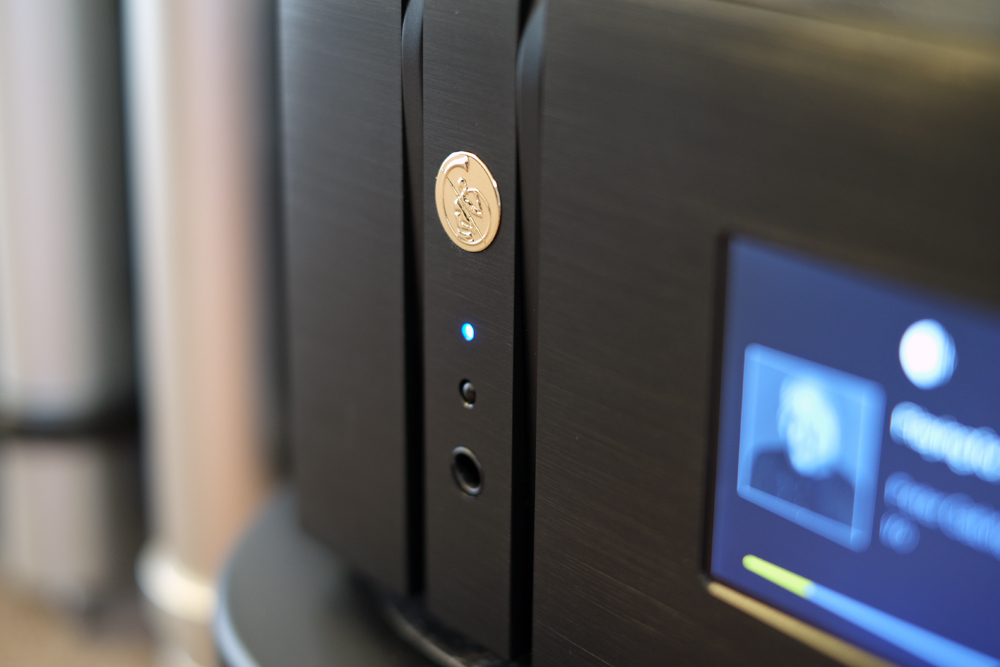
Ditto for venue ambience champs with audiophile staples like Harry Belafonte’s Live At Carnegie Hall and The Weavers’ Reunion at Carnegie Hall: 1963 where the iconic venue’s acoustic/spatial signature was enveloping. Impressive too, was Belafonte’s tight image tracking as the singer roamed around the large stage.
Subtle, well recorded music returned a big boon via the DS-1000 EVO. “Blues in The Closet” from Tsuyoshi Yamamoto Trio’s Blues For K album captured the group’s tight musicianship in a captivating way. The interplay between masterful piano, bass and drums was expertly separated. I was able to easily follow each instrument as both an individual strand and holistically as a trio playing in unison. Again, the low-level minutiae of each instrument’s timbral signature, the instrumentalists’ playing technique and their accentuations were superbly exhibited via the streaming DAC.
Conclusion
It’s true that streaming has come a long way. I recall, many years ago, reviewing an early streaming/computer audio product which almost required an IT Diploma to setup and operate. Plus, it demanded separate servers, renderers and software add-ons in order to sound… barely decent. Don’t even go there comparing performance with, at the time, the very powerful CD format. No contest.
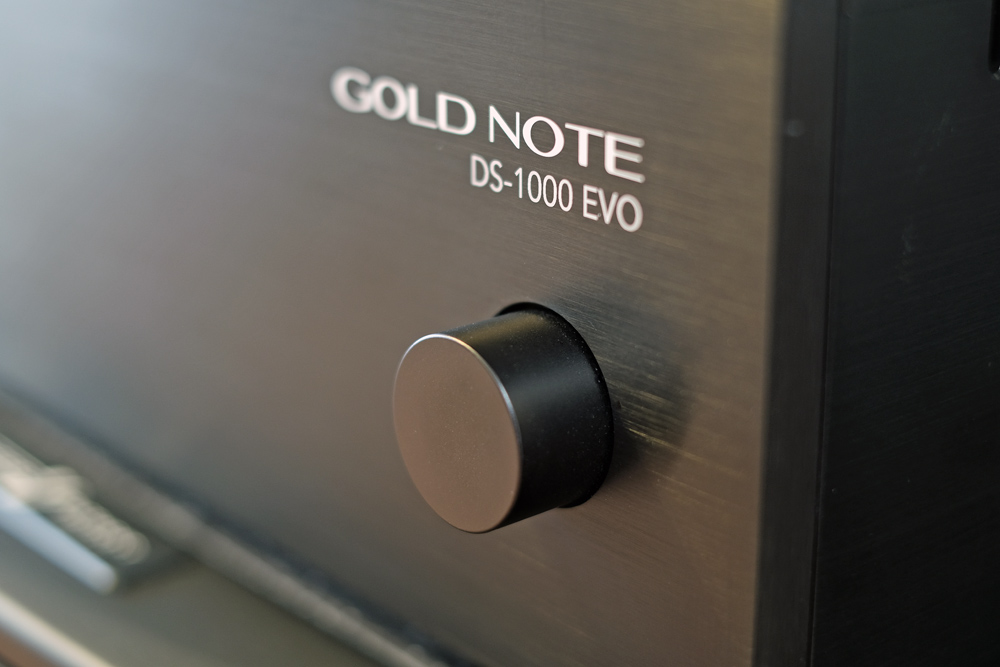
However, in the 21st century, the digital music player space has evolved to a point where it’s unrecognisable when juxtaposed with early versions. There’s now an abundance of very capable high performance products, by new and established players from around the world, which are UPnP-easy. With the Gold Note DS-1000 EVO, you have a component which is simple to setup and configure. It can play all-manner of files and formats while seamlessly streaming the plethora of services available today. What’s more, the company’s engineers have generously added a super DAC section, a very competent headphone amplifier and, with the ‘Line’ version, an option to expand with analogue component inclusion via a Class-A preamplification stage.
Hey, I’d go as far as saying that, given the wealth of excellent products at all price points, the undisputable performance potential, the staggering levels of music availability, and the near-foolproof ease of use, digital music playback may just have entered a Golden Age. The Gold Note DS-1000 EVO is there, armed to the teeth, among the most powerful digital contenders.
… Edgar Kramer
This email address is being protected from spambots. You need JavaScript enabled to view it.
Associated Equipment
- Speakers — Wilson Audio Alexia V, Axis Loudspeakers VoiceBox S (nearfield monitor), Vermouth Audio Little Luccas Mk.II, Atacama stands
- Amplifier — Gryphon Audio Antileon EVO
- Preamplifier — Supratek Cortese, Totaldac d1-triunity (direct to amplifier)
- Sources — Digital: 432 EVO Aeon Mk.3 Reference Music Server/Roon Core, Yamaha CD-S2100 transport, Totaldac d1-triunity DAC. Analogue: Transrotor Crescendo with Konstant Studio controller, Reed 1X Tonearm with upgraded internal wiring, Shelter Harmony cartridge, The Funk Firm Houdini cartridge decoupler, Supratek Cortese & REDGUM Audio RGPH2 phono stages
- Processor — DEQX PreMate (part of arsenal/casual use)
- Cables — VYDA Laboratories Orion Silver Reference HFC IC and speaker cables, PSC Audio custom design XLR, Vermouth Audio Reference loom,ZenSati Zorro, Tubulus Concentus USB
- Audio Rack — SGR Audio Statement Model V, Aspire Audio Belgravia amplifier platform (customised for Gryphon Audio Antileon EVO), Stereotech Aluminar Dark 3-tier rack
- Acoustic Treatment — Vicoustic Multifuser Wood, Wavewood Ultra, Cinema Round Premium and Super Bass Extreme
- Miscellaneous — Silent Angel Bonn N8 Pro network switch, GigaWatt PF-1 EVO power strip, Les Davis Audio Viscoelastic CLD discs, VRC Vinyl Record Cleaning systemplus miscellaneous accessories
Gold Note DS-1000 EVO Streaming Digital-to-Analogue Converter
Price: AU$12,000, AU$15,750 (DS-1000 EVO Line)
Australian Warranty: Two Years
Australian Distributor: Audio Heaven
+61 (0) 412 650 723
www.audioheaven.com.au
Gold Note
Via Virginio 158
50025 Montespertoli
Firenze
Italy
+39 0571675005
www.goldnote.it
